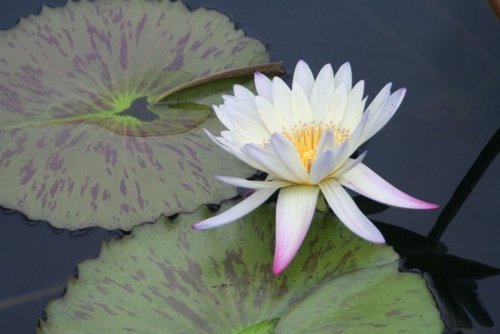White Water Lily
(Nymphaea ‘Marliacea Carnea’)
NYC Botanical Gardens, 2007
White Water Lily
(Nymphaea ‘Marliacea Carnea’)
Nymphaea ‘Marliacea Carnea’ is a stunning hardy water lily cultivar known for its delicate white petals tinged with soft pink and its golden-yellow center. This elegant aquatic plant is cherished for its romantic coloration, making it a favorite in garden ponds and water features.
Origins & History
This variety was developed by Joseph Bory Latour-Marliac, a renowned 19th-century French horticulturist. Marliac was famous for hybridizing hardy water lilies, introducing a range of colors beyond the traditional white. ‘Marliacea Carnea’ was one of his successful creations, blending the resilience of European Nymphaea alba with the vibrant hues of tropical lilies. As a water lily, ‘Marliacea Carnea’ is often associated with purity, enlightenment, and transformation. The soft pink hues give it an air of gentleness and serenity, making it a breathtaking centerpiece for any water garden.
Appearance
Flowers: Blooms are 5–6 inches (12–15 cm) wide, opening in the morning and closing by late afternoon. The petals start as a creamy white and gradually show a soft pink blush toward the edges, deepening slightly with age.
Leaves: Large, rounded, and green with a bronze tint when young. They provide ample shade for aquatic life.
Growth Habit: A prolific bloomer from late spring to early autumn, producing numerous flowers throughout the season.
Growing Conditions
Water Depth: Thrives in 12–36 inches (30–90 cm) of water, making it ideal for both shallow and deep ponds.
Sunlight: Requires full sun (at least 6+ hours daily) to encourage strong blooming.
Soil: Prefers loamy or clay-based aquatic soil placed in a planting basket or directly in pond substrate.
Winter Hardiness: Fully hardy in USDA zones 4–11. It can survive freezing winters if the rhizome remains below ice formation.
Care & Maintenance
Fertilization: Apply slow-release aquatic fertilizer every 4–6 weeks during the growing season.
Pruning: Remove spent flowers and yellowing leaves to promote continuous blooms and prevent decay.
Propagation: Best propagated by dividing rhizomes in early spring before active growth begins.
Wildlife & Ecological Benefits
Attracts pollinators, such as bees and beetles, which help fertilize the flowers.
Provides shade and shelter for fish, frogs, and other aquatic creatures.
Helps oxygenate water and reduce algae growth by limiting sunlight penetration.

